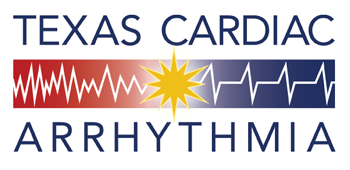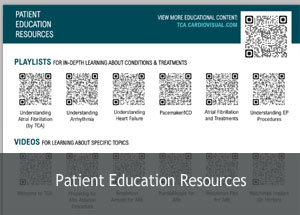Patient Education
Heart Arrhythmias and DisordersArrhythmias That Originate In The Heart’s Upper Chambers, The Atria
Atrial Fibrillation (AF Or A Fib)
More than 2 million people in the United States have atrial fibrillation, making it a very common heart rhythm disorder. In A Fib, the heartbeat is irregular and rapid, sometimes beating as often as 300 times a minute, about four times faster than normal. Although it isn’t life threatening, A Fib can lead to other rhythm problems, chronic fatigue and congestive heart failure. Chances of having a stroke are five times higher for those with A Fib.
Atrial Flutter (AFL)
Atrial flutter is similar to A Fib because it too is characterized by a rapid heartbeat. Instead of many disorganized signals, however, AFL is caused by a single electrical wave that circulates very rapidly in the atrium, about 300 times a minute, leading to a very fast, steady heartbeat.
Sick Sinus Syndrome (SSS)
SSS is not a specific disease, but a group of signs or symptoms that indicate the heart’s natural electrical pacemaker, the sinoatrial node, is not functioning properly. In SSS, the heart rate can switch back and forth between a slow rate (bradycardia) and a fast rate (tachycardia). A permanent pacemaker, sometimes in combination with medication, is the primary treatment.
Sinus Tachycardia
A harmless rhythm, sinus tachycardia is a normal increase in heart rate that happens with fever, excitement and exercise. It does not require treatment except in rare cases when an underlying problem, such as anemia or hyperthyroidism, should be treated.
Arrhythmias That Originate In The Heart’s Lower Chambers, The Ventricles
Ventricular Tachycardia (VT)
Characterized by a very fast heart rate,VT usually is seen in the setting of other serious heart disease. Occasionally, it occurs in people with normal hearts. It usually requires prompt treatment, sometimes with medication. Sometimes it is treated with radiofrequency ablation or surgery.Often people with VT are protected by implantation of a defibrillator. Because VT can lead to ventricular fibrillation (next item) it is considered a serious condition that warrants aggressive monitoring and treatment.
Ventricular Fibrillation (VF)
Sudden cardiac death, caused by ventricular fibrillation, poses the greatest threat and accounts for half of all cardiac deaths. In VF, the heartbeat is rapid and chaotic,which causes the lower heart chambers, or ventricles, to go into a spasm. Sometimes, however, a heart attack can lead to VF. VF is abrupt and happens without any warning and it halts all heart functioning.The lack of oxygen throughout the body, and especially to the brain, is deadly.Also known as cardiac arrest, sudden cardiac death is due to an electrical circuitry problem. It is not the same as a heart attack, or myocardial infarction,which is a circulatory problem caused by clogged blood vessels that cut off the supply of blood to the heart.
Although CPR can provide some benefit, the only truly effective VF treatment is defibrillation, which relies on paddles or electrodes to “shock” the heart back to normal rhythm. Without treatment, loss of consciousness comes in seconds, and death is inevitable.
Other Premature Contractions
Extra, early or “skipped” beats are the most frequent cause of irregular heart rhythms.These can start in the upper or lower chambers of the heart
Long QT Syndrome (LQTS)
Long QT Syndrome is a disorder of the electrical system. It can be inherited, acquired after taking certain medications, or caused by a combination of heredity and medications. People with LQTS are susceptible to ventricular fibrillation.
Heart Block
When electrical impulses generated in the upper chambers of the heart are not properly transmitted to the lower chambers,Heart Block happens.The heart then beats too slowly,reducing the oxygen that gets to the body and brain.
Syncope (Fainting)
Fainting, or feeling as if one might faint, can be caused by serious heart rhythm disorders and needs to be evaluated carefully. Sometimes the cause is not heart related, for instance when low blood sugar is to blame, but still can be dangerous.No matter what the cause, fainting can be dangerous simply because of the potential for injuries from falling.
Circulatory
Heart Attack (Myocardial Infarction)
When arteries are clogged to the point of decreasing or stopping the flow of blood to the heart muscle, a lack of oxygen damages or kills heart muscle causing a heart attack. Recognizing symptoms and getting prompt emergency treatment can eliminate, prevent or limit the amount of heart muscle damage.
Stroke
Although not true “heart” disorders, strokes are a related condition. While some strokes occur when a blood vessel bursts, most strokes happen for the same reasons as a heart attack, clogged or blocked vessels.All strokes pose serious health threats.
Structural
Heart Failure
When the heart muscle is too weak to effectively pump blood through the body, heart failure, or cardiomyopathy, sets in. Early diagnosis and treatment can stop or slow progression of heart failure.
Heart Valve Problems
Heart valve problems can be inherited or can develop and can wreak havoc on the heart’s ability to push blood from chamber to chamber.Medication and surgery are treatment options.




